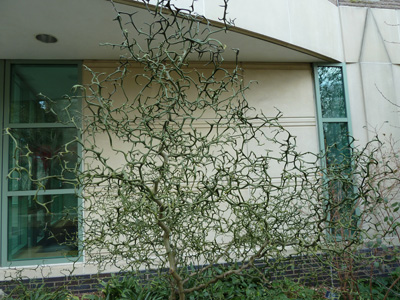Plants of the Week – January 30
 Looking for a spreading evergreen groundcover for the shade? Consider Epimedium perralchicum ‘Frohnleiten’. The yellow barrenwort, a member of Berberidaceae, is a German introduction selected for durable marbled foliage and sprays of yellow spring-blooming flowers. While it will take several seasons to reach mature size, the plant is long-lived and only improves with age. Prune old leaves to the ground in late winter. Drought tolerant once established. Photo credit: J. Coceano
Looking for a spreading evergreen groundcover for the shade? Consider Epimedium perralchicum ‘Frohnleiten’. The yellow barrenwort, a member of Berberidaceae, is a German introduction selected for durable marbled foliage and sprays of yellow spring-blooming flowers. While it will take several seasons to reach mature size, the plant is long-lived and only improves with age. Prune old leaves to the ground in late winter. Drought tolerant once established. Photo credit: J. Coceano
 Ilex crenata Drops of GoldTM was discovered as a branch sport on Ilex crenata ‘Hetzii’. Glossy evergreen leaves change to golden yellow when exposed to direct sunlight. While the Japanese holly will grow in lightly shaded locations, best coloration is achieved when exposed to full sun. Mature plants reach 2-3’ in height with a spread of 3-4’. Photo credit: J. Coceano
Ilex crenata Drops of GoldTM was discovered as a branch sport on Ilex crenata ‘Hetzii’. Glossy evergreen leaves change to golden yellow when exposed to direct sunlight. While the Japanese holly will grow in lightly shaded locations, best coloration is achieved when exposed to full sun. Mature plants reach 2-3’ in height with a spread of 3-4’. Photo credit: J. Coceano
 Poncirus trifoliata ‘Flying Dragon’ is a plant with personality. Twisting stems lined with numerous spines jut out in every direction. This cultivar is used as a specimen in the Winter Garden while the species is often planted as a screening shrub in the south. As Michael Dirr says “… no sane person would attempt to penetrate this hedge.” Photo credit: J. Coceano
Poncirus trifoliata ‘Flying Dragon’ is a plant with personality. Twisting stems lined with numerous spines jut out in every direction. This cultivar is used as a specimen in the Winter Garden while the species is often planted as a screening shrub in the south. As Michael Dirr says “… no sane person would attempt to penetrate this hedge.” Photo credit: J. Coceano
 Nandina domestica ‘Moonbay’ is a small compact shrub reaching 30 inches in height with a similar spread. Its evergreen nature is ideal for low screening as seen here where it masks the support of a Swarthmore College campus map. New growth turns red in autumn and lasts throughout the winter months. Photo credit: J. Coceano
Nandina domestica ‘Moonbay’ is a small compact shrub reaching 30 inches in height with a similar spread. Its evergreen nature is ideal for low screening as seen here where it masks the support of a Swarthmore College campus map. New growth turns red in autumn and lasts throughout the winter months. Photo credit: J. Coceano





Katrina Van Duyn
Posted at 13:10h, 02 FebruaryThank you for this post. Will all the epimediums, once established, respond well to late-winter pruning to the ground?
Josh Coceano
Posted at 14:27h, 02 FebruaryYes, you should cut epimedium to the ground in late winter or early spring before the new flush of foliage and flowers emerge. Otherwise it is difficult to cutback last years tattered growth without damaging the new growth.
We wait a bit longer on E. perralchichum ‘Frohnleiten’ as it is such a resilient winter ground cover but have begun cutting back other species.